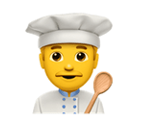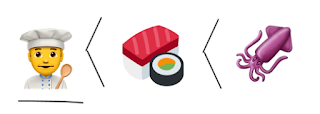An Emoji Language
Reading this month's First Monday, which was a special issue on the emoji, inspired me to a creative thought, which I document here.
The thought has two parts:
- first, there's the (probably unoriginal) thought that the existing and future set of emoji (or, related, emoticons, or icons (including, say, font-awesome) in general) can or will constitute a language. Such a language would have the advantage of being international, easy to learn, and reasonably expressive.
- second, the possibly original thought that we can (and should) make the language of emoji that much more expressive with a simple set of diacritical marks.
Let me explain. Here's a typical emoji, which we might call a chef or a cook or a baker:
With the addition of just a few marks we can create what is sometimes called a 'word family' - a set of linguistic moves around a single concept.
Noun
Add a 'hat' or 'roof' to specify that our icon refers to a thing (specifically, a person), who is a cook:
Being
The idea of something being something else is a core linguistic function. These expressions can be literal, as in 'Socrates is a man', or they can be metaphorical, as in 'Lena is a table'. The cook emoji can similarly express 'being a cook'. We'll use a single mark to indicate being, as follows:
If we wish to assert that some specific thing is something, this mark allows us to use whatever signifier we want for that thing. For example, "Stephen is a Cook".
Or even better...
If we want to be even more specific, we can insert a QR code in place of the image icon, and the reader can go directly to the page representing that person or object.
Adjective / Adverb
Adjectives modify nouns, and adverbs modify verbs, so we can handle both concepts with a single mark. Also, both adjectives and adverbs can be stacked, that is, multiple adjectives or adverbs can modify a single noun or verb. So we'll use the same arrow-like mark pointing to the thing being modified, like this:
This is a squid cook (or, possibly, in a different context, a cook that resembles a squid - we can allow for some double meanings an puns; no good language is complete without them).
This is squid cooking. (Note that in a lot of cases, the diacritical marks can be omitted, if the conext collapses or is in some way obvious - here, for example, pretty much any interpretation will reduce to 'squid cooking' or 'squid cook' (which are themselves closely related) so the marks would probably be optional in day-to-day usage.)
Conjunctions
Just a couple more and we're done: conjunctions (or, viewed from a different perspective, propositional operators): 'and', 'or', 'if-then', 'not'. The symbols are what you would expect:
These are placed in between emoji or groups of emoji and mean basically what we think they would mean. For example:
This means 'Cooking squid or sushi'. As an interesting sidenote, take the 'or' symbol away and replace it (optionally) with the modifier symbol and you have, and you have:
Cooking squid sushi.
These are the basics, and I'll end the post here (rather than build the entire language). I think that things like prepositions and modalities can be created from the emoji themselves. Things like universality and specificity are implicit (and more specifically, a universal is any conditional that does not specifically reference being.
Maybe the new language of emoji will evolve this way, and maybe it won't. But I would be very surprised is some means for expressing these concepts were not incorporated, as they enable emoji to evolve from a simple system of reference to a fully expressive international language.
The thought has two parts:
- first, there's the (probably unoriginal) thought that the existing and future set of emoji (or, related, emoticons, or icons (including, say, font-awesome) in general) can or will constitute a language. Such a language would have the advantage of being international, easy to learn, and reasonably expressive.
- second, the possibly original thought that we can (and should) make the language of emoji that much more expressive with a simple set of diacritical marks.
Let me explain. Here's a typical emoji, which we might call a chef or a cook or a baker:
With the addition of just a few marks we can create what is sometimes called a 'word family' - a set of linguistic moves around a single concept.
Noun
Add a 'hat' or 'roof' to specify that our icon refers to a thing (specifically, a person), who is a cook:
Verb
Add a line or a swoosh under the icon to signify that it's a verb. In this case, our very would mean something like 'cooking' or 'baking'.
The idea of something being something else is a core linguistic function. These expressions can be literal, as in 'Socrates is a man', or they can be metaphorical, as in 'Lena is a table'. The cook emoji can similarly express 'being a cook'. We'll use a single mark to indicate being, as follows:
If we wish to assert that some specific thing is something, this mark allows us to use whatever signifier we want for that thing. For example, "Stephen is a Cook".
Or even better...
If we want to be even more specific, we can insert a QR code in place of the image icon, and the reader can go directly to the page representing that person or object.
Adjective / Adverb
Adjectives modify nouns, and adverbs modify verbs, so we can handle both concepts with a single mark. Also, both adjectives and adverbs can be stacked, that is, multiple adjectives or adverbs can modify a single noun or verb. So we'll use the same arrow-like mark pointing to the thing being modified, like this:
This is a squid cook (or, possibly, in a different context, a cook that resembles a squid - we can allow for some double meanings an puns; no good language is complete without them).
This is squid cooking. (Note that in a lot of cases, the diacritical marks can be omitted, if the conext collapses or is in some way obvious - here, for example, pretty much any interpretation will reduce to 'squid cooking' or 'squid cook' (which are themselves closely related) so the marks would probably be optional in day-to-day usage.)
Conjunctions
Just a couple more and we're done: conjunctions (or, viewed from a different perspective, propositional operators): 'and', 'or', 'if-then', 'not'. The symbols are what you would expect:
These are placed in between emoji or groups of emoji and mean basically what we think they would mean. For example:
This means 'Cooking squid or sushi'. As an interesting sidenote, take the 'or' symbol away and replace it (optionally) with the modifier symbol and you have, and you have:
Cooking squid sushi.
These are the basics, and I'll end the post here (rather than build the entire language). I think that things like prepositions and modalities can be created from the emoji themselves. Things like universality and specificity are implicit (and more specifically, a universal is any conditional that does not specifically reference being.
Maybe the new language of emoji will evolve this way, and maybe it won't. But I would be very surprised is some means for expressing these concepts were not incorporated, as they enable emoji to evolve from a simple system of reference to a fully expressive international language.












Comments
Post a Comment
Your comments will be moderated. Sorry, but it's not a nice world out there.